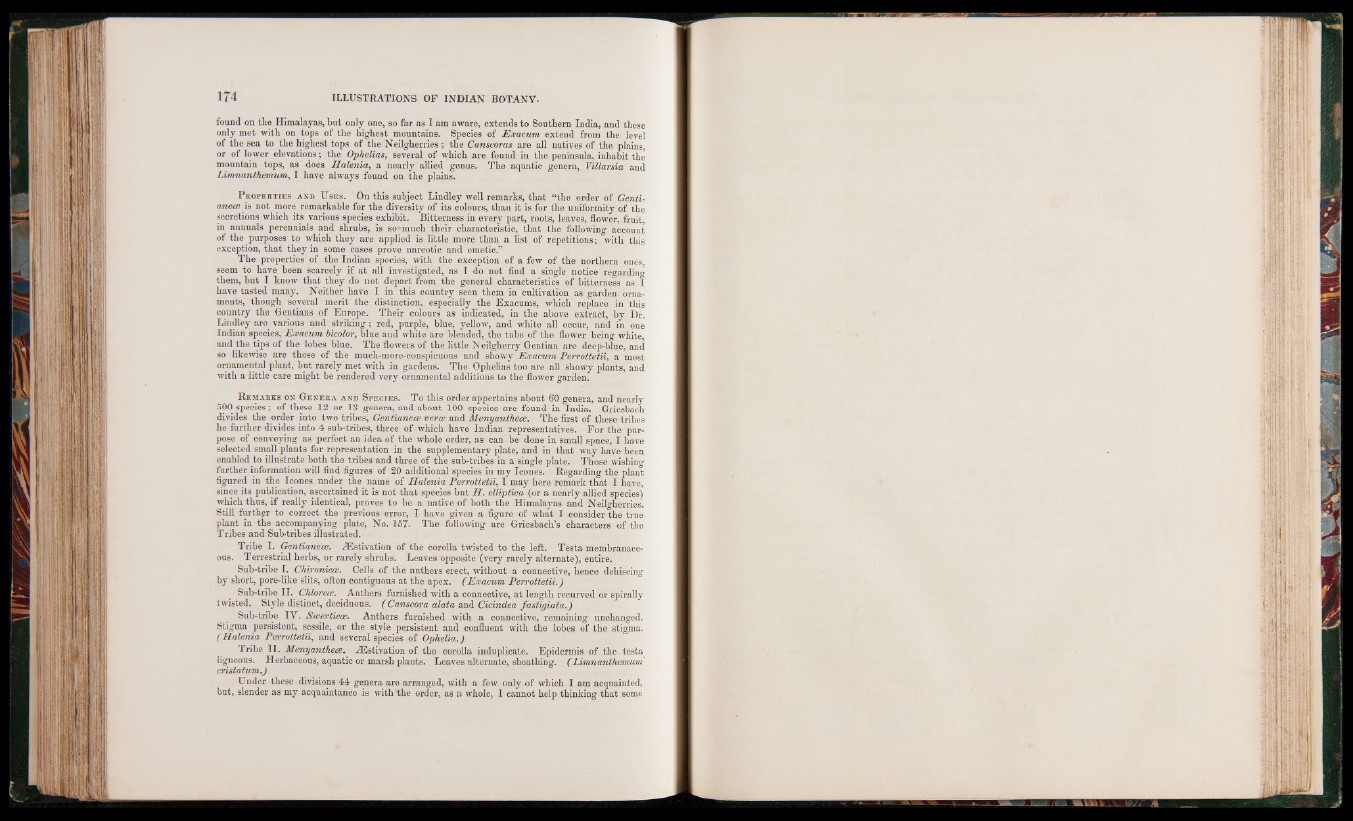
found on the Himalayas, but only one, so far as I am aware, extends to Southern India, and these
only met with on tops of the highest mountains. Species of Eooacum extend from the level
of the sea to the highest tops of the Neilgherries; the Canscoras are all natives of the plains
or of lower elevations; the Ophelias, several of which are found in the peninsula, inhabit the
mountain tops, as does Halenia, a nearly allied genus. The aquatic genera, Villarsia and
Limnanthemum, I have always found on the plains.
P r o p e r t ie s a n d U s e s . On this subject Lindley well remarks, that “the order of Genii-
anece is not more remarkable for the diversity of its colours, than it is for the uniformity of the
secretions which its various species exhibit. Bitterness in every part, roots, leaves, flower, fruit
in annuals perennials and shrubs, is so^much their characteristic, that the following account
of the purposes to which they are applied is little more than a list of repetitions; with this
exception, that they in some cases prove narcotic and emetic.”
The properties of the Indian species, with the exception of a few of the northern ones,
seem to have been scarcely if at all investigated, as I do not find a single notice regarding
them, but I know that they do not depart from the general characteristics of bitterness as I
have tasted many. Neither have I in this country seen them in cultivation as garden ornaments,
though several merit the distinction, especially the Exacums, which replace in this
country the Gentians of Europe. Their colours as indicated, in the above extract, by Dr.
Lindley are^ various and striking; red, purple, blue, yellow, and white all occur, and in one
Indian species, Eooacum bicolor, blue and white are blended, the tube of the flower being white,
and the tips of the lobes blue. The flowers of the little Neilgherry Gentian are deep-blue, and
so likewise are those of the much-more-conspicuous and showy Eooacum Perrottetii, a most
ornamental plant, but rarely met with in gardens. The Ophelias too are all showy plants, and
with a little care might be rendered very ornamental additions to the flower garden.
R em a r k s on G e n e r a a n d S p e c ie s . T o this order appertains about 60 genera, and nearly
500 species; of these 12 or 13 genera, and about 100 species are found in India. Griesbach
divides the order into two tribes, Gentianeee verce and Menyanthece. The first of these tribes
he further divides into 4 sub-tribes, three of which have Indian representatives. For the purpose
of conveying as perfect an idea of the whole order, as can be done in small space, I have
selected small plants for representation in the supplementary plate, and in that way have been
enabled to illustrate both the tribes and three of the sub-tribes in a single plate. Those wishing
further information will find figures of 20 additional species in my leones. Regarding the plant
figured in the leones under the name of Halenia Perrottetii, I may here remark that I have,
since its publication, ascertained it is not that species but H. elliptica (or a nearly allied species)
which thus, if really identical, proves to be a native of both the Himalayas and Neilgherries.
Still further to correct the previous error, I have given a figure of what I consider the true
plant in the accompanying plate, No. 157. The following are Griesbach’s characters of the
Tribes and Sub-tribes illustrated.
Tribe I. Gentianeee. ^Estivation of the corolla twisted to the left. Testa membranaceous.
Terrestrial herbs, or rarely shrubs. Leaves opposite (very rarely alternate), entire.
Sub-tribe I. Chironiece. Cells of the anthers erect, without a connective, hence dehiscing
by short, pore-like slits, often contiguous at the apex. (Eooacum Perrottetii.)
Sub-tribe II. Chlorece. Anthers furnished with a connective, at length recurved or spirally
twisted. Style distinct, deciduous. ( Canscora alata and Cicindea fastigiata.)
Sub-tribe IY. Swertiece. Anthers furnished with a connective, remaining unchanged.
Stigma persistent, sessile, or the style persistent and confluent with the lobes of the stigma.
(Halenia Perrottetii, and several species of Ophelia.)
Tribe II. Menyanthece. ^Estivation of the corolla induplicate. Epidermis of the testa^
ligneous. Herbaceous, aquatic or marsh plants. Leaves alternate, sheathing. (Limnanthemum
cristatum.)
Under these divisions 44 genera are arranged, with a few only of which I am acquainted,
but, slender as my acquaintance is with the order, as a whole, I cannot help thinking that some